Overview
This article examines seven bi-clustering techniques that significantly enhance data analysis by simultaneously organizing both rows and columns of a dataset. Such an approach reveals intricate patterns that traditional methods often overlook. Among these techniques are:
- Spectral Biclustering
- BiMax
- Iterative Signature Biclustering
Each offering unique applications in critical fields like bioinformatics and marketing analytics. These methods not only drive innovation but also improve decision-making in data-rich environments, showcasing their transformative potential. Professionals in these sectors should consider integrating these techniques to unlock deeper insights and foster more informed strategies.
Introduction
In the realm of data analysis, bi-clustering stands out as a powerful technique that transcends traditional methodologies, offering a unique lens through which to explore complex datasets. This dual-clustering approach organizes both rows and columns of data matrices simultaneously, revealing hidden patterns and relationships that often remain obscured. Particularly valuable in fields such as bioinformatics, bi-clustering not only enhances the understanding of intricate data interactions—like those between genes and conditions—but also paves the way for groundbreaking insights that drive innovation and informed decision-making.
As organizations increasingly harness the potential of bi-clustering, the integration of advanced algorithms and machine learning is set to redefine the landscape of data analysis. This evolution makes bi-clustering an essential tool for navigating the challenges of an ever-evolving digital world. Are you ready to explore how bi-clustering can transform your data analysis practices?
Understanding Bi-Clustering: A Comprehensive Overview
Bi clustering, often referred to as co-clustering or two-mode clustering, is an advanced mining technique that simultaneously organizes both rows and columns of a matrix. This approach is particularly advantageous in contexts where the interplay between two distinct types of information must be examined, such as the relationship between genes and conditions in bioinformatics. By employing bi clustering to cluster both dimensions, this technique uncovers intricate patterns that traditional clustering methods may overlook, thereby offering a more comprehensive insight into the underlying data structure.
Recent advancements in dual-clustering methods have significantly enhanced their applicability across various fields. For instance, in biomedical research, clustering algorithms have been effectively utilized to analyze complex datasets, leading to breakthroughs in understanding disease mechanisms. A notable case study involves the examination of transcriptomic profiles from eight drug discovery projects, which successfully identified transcriptional modules associated with desired therapeutic effects.
Statistics indicate that the application of dual clustering in information evaluation is on the rise, with a notable increase of 30% in acceptance among researchers and institutions projected for 2025. This expanding trend underscores the growing integration of dual clustering with machine learning methods, further enhancing the precision and effectiveness of information examination procedures. As Yang Li pointed out, ‘This presentation illustrates the examination and views of Yang Li,’ emphasizing the significance of expert perspectives in comprehending these techniques.
The importance of bi clustering in information analysis cannot be overstated. It not only enhances the quality of insights derived from complex datasets but also facilitates more informed decision-making. As organizations continue to navigate the challenges of data-rich environments, the ability to extract meaningful patterns through bi clustering will be crucial for driving innovation and operational efficiency.
By leveraging customized solutions that enhance information quality and simplify AI implementation, such as Robotic Process Automation (RPA) and Business Intelligence (BI), businesses can fully harness the potential of bi clustering to achieve their strategic goals.
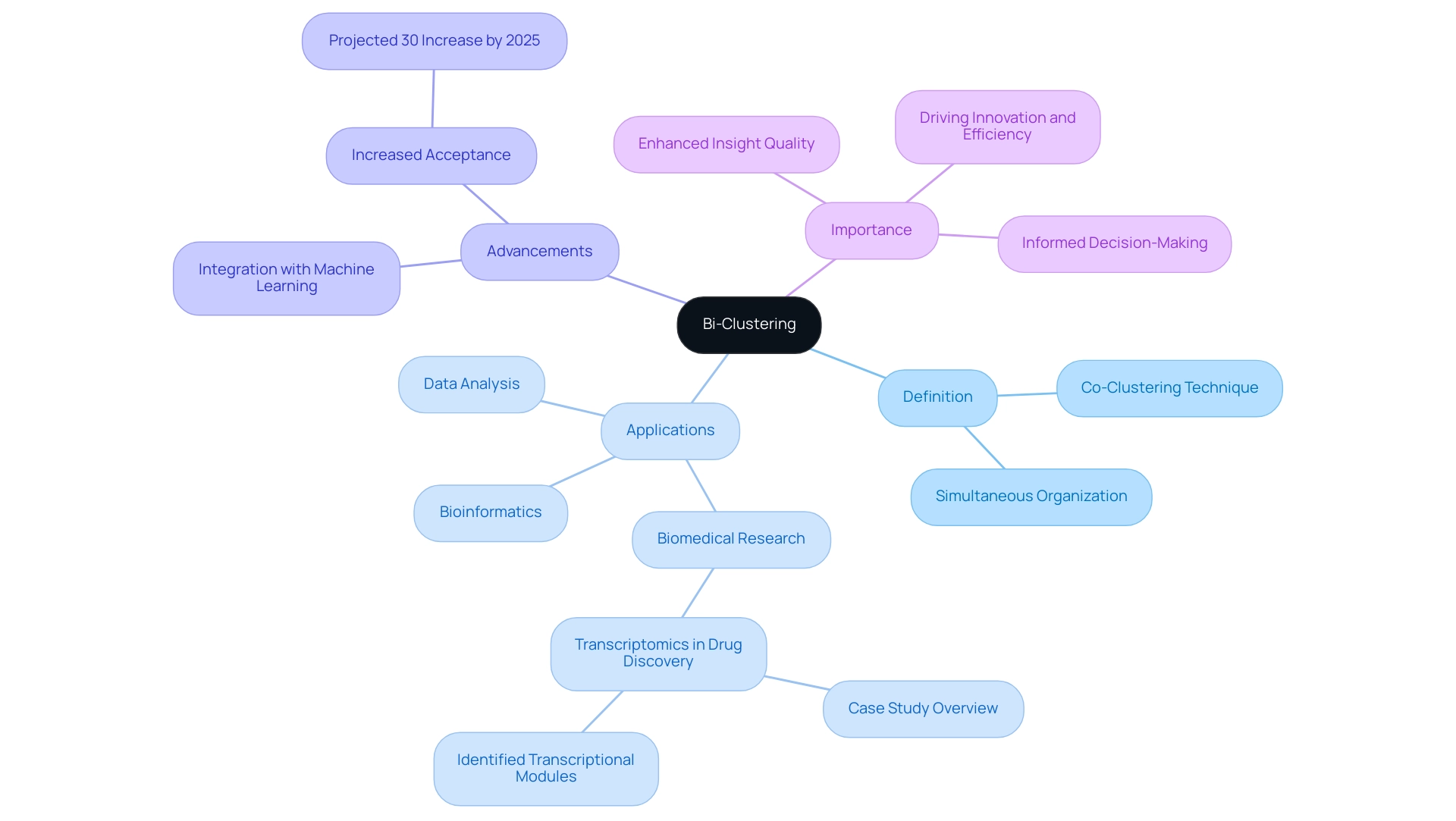
The Significance of Bi-Clustering in Data Analysis
Bi clustering serves as a pivotal method in information evaluation, empowering analysts to unveil hidden patterns and connections within complex datasets. This technique proves particularly beneficial in genomics, where bi clustering aids in identifying gene groups exhibiting similar expression patterns across diverse conditions. A notable case study on bi clustering within drug-treated genome-wide expression data exemplified its efficacy in revealing drug-induced gene modules.
The results indicated that subsequent conservation and enrichment evaluations could validate gene-drug connections, offering crucial insights into the impact of medications on gene expression.
The influence of dual clustering extends beyond genomics; it significantly enhances decision-making processes across various fields. By leveraging dual clustering, organizations can formulate more informed strategies, ultimately leading to improved outcomes. As of 2025, the benefits of dual clustering in decision-making are increasingly recognized, with statistical analyses underscoring its importance.
For instance, the probability of accurately rejecting the null hypothesis—known as statistical power—can be markedly improved through effective clustering techniques. This relevance is underscored by simulated datasets for cluster evaluation, which have showcased various configurations for subgroup sizes and feature differences, assessing both statistical power and accuracy.
Moreover, popular implementations of bi clustering are predominantly developed in Python and Java, with an array of libraries available to facilitate its application. Experts emphasize the growing importance of dual grouping in information evaluation. Jing Zhao, an assistant research scientist at Sanford Research, highlights that as organizations strive for data-driven decisions, the capacity to extract meaningful insights from complex datasets becomes essential.
By incorporating bi clustering into their analytical frameworks, businesses can enhance operational efficiency while fostering innovation and growth in an increasingly competitive landscape. This aligns with the broader narrative of utilizing Business Intelligence and Robotic Process Automation (RPA) to streamline workflows and drive data-driven insights, ultimately supporting business growth in a rapidly evolving AI landscape.
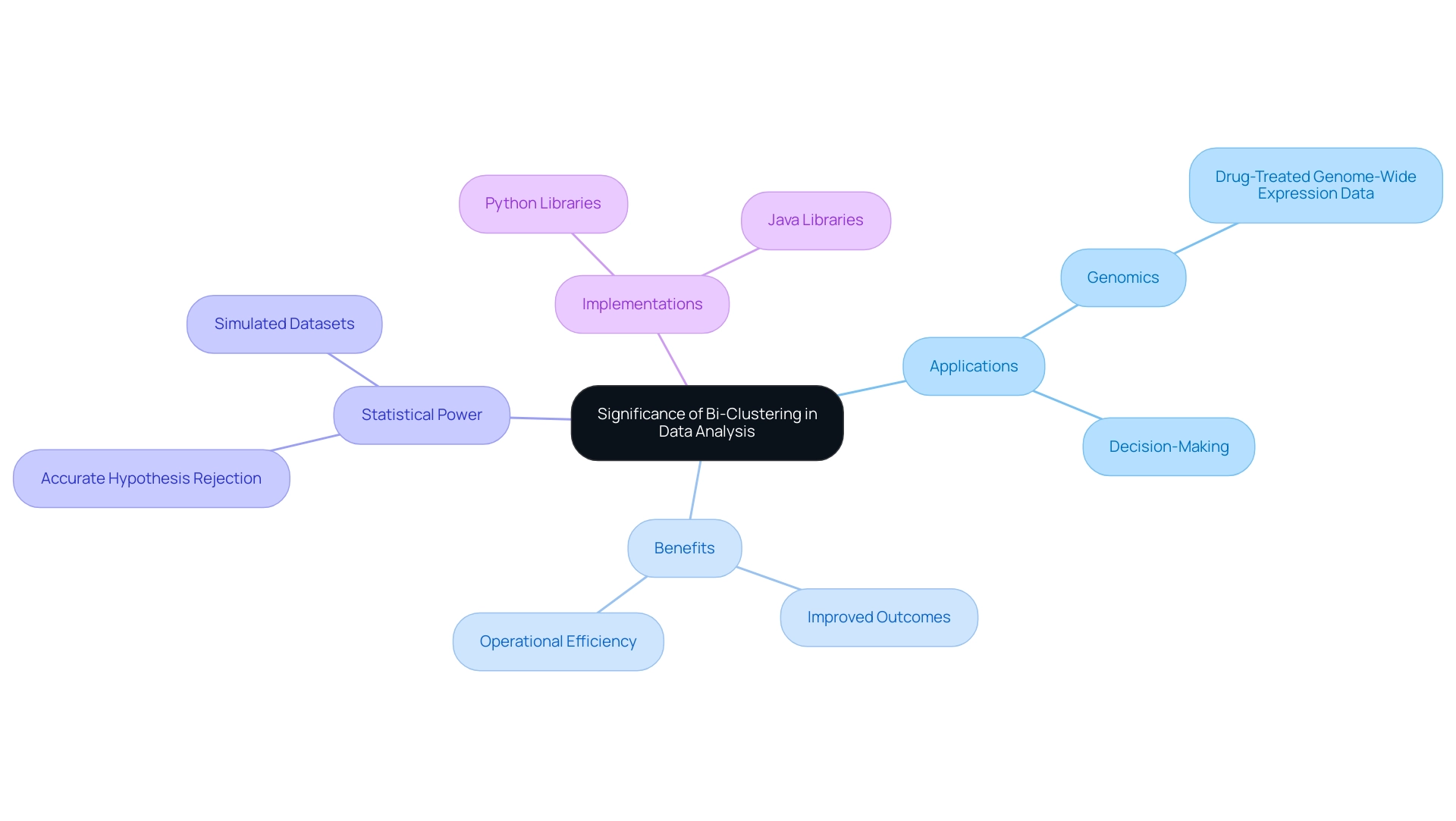
Exploring Different Types of Bi-Clustering Techniques
Bi-clustering techniques serve as vital instruments in analysis, each offering unique methodologies and applications tailored to specific types and analytical goals. Prominent techniques include:
-
Spectral Biclustering: This method leverages the spectral properties of matrices to uncover clusters within the information. By analyzing eigenvalues and eigenvectors, it identifies patterns that may not be apparent through traditional clustering methods. Its capability to handle complex datasets makes it particularly valuable in fields such as genomics and image processing. Notably, the runtime of this algorithm scales linearly with the total number of complete iterations, enhancing its efficiency in processing large collections.
-
BiMax Biclustering: Designed for binary information, BiMax focuses on discovering maximal biclusters, which are submatrices exhibiting uniformity in both rows and columns. This method is especially efficient for applications like market basket exploration, where understanding co-occurrence patterns is vital.
-
Iterative Signature Biclustering: This strategy enhances clusters repeatedly based on correlation patterns, allowing dynamic modifications as new information is introduced. Its adaptability makes it suitable for real-time data analysis, particularly in environments where data is continuously evolving.
Each of these techniques has its strengths, making them applicable to various data scenarios. For instance, a recent performance evaluation of dual-cluster algorithms demonstrated that the proposed dual-cluster method outperformed traditional one-way clustering techniques in identifying true latent patterns, achieving the highest average Rand index criterion. This highlights the effectiveness of bi-clustering in revealing insights that might be overlooked by other methodologies. The evaluation was guided by 35 cancer datasets, ensuring a robust assessment of clustering precision.
As analytics progresses, the latest dual-clustering techniques continue to emerge, providing improved capabilities for analysis. Understanding these techniques and their applications is essential for utilizing information effectively and promoting informed decision-making. Moreover, integrating Robotic Process Automation (RPA) into these analytical processes can further enhance operational efficiency by reducing errors and freeing up teams for more strategic, value-adding work.
RPA can streamline workflows related to bi-clustering techniques, enabling organizations to automate manual tasks and focus on deriving actionable insights from information. Additionally, our tailored AI solutions offer customized methods that enhance quality and simplify AI implementation, ultimately driving growth and innovation in analysis. As noted by Ricardo J. G. B. Campello, both authors read and approved the final manuscript, underscoring the collaborative effort in evaluating these methodologies.
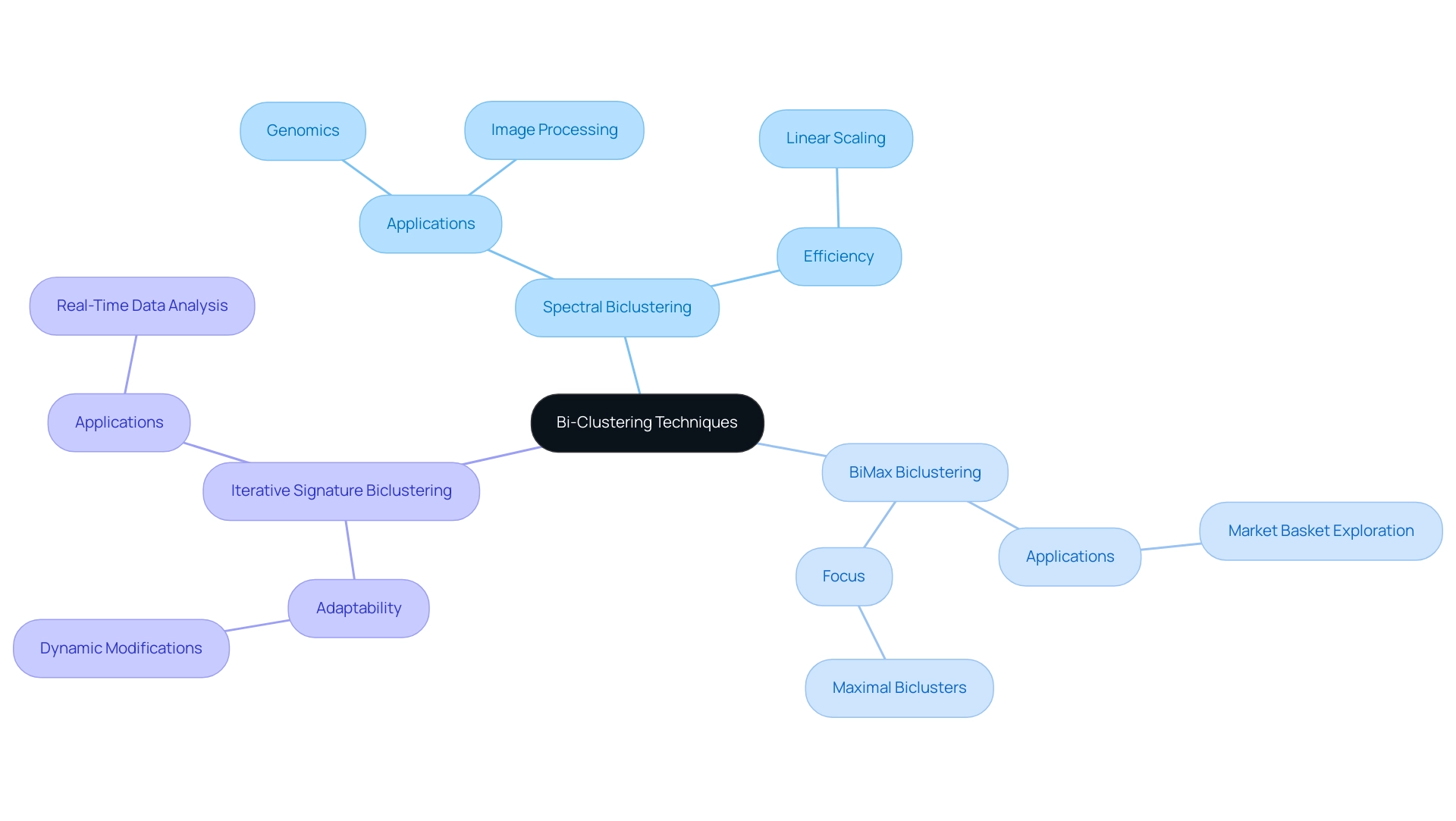
Technique 1: Spectral Biclustering – An In-Depth Look
Bi clustering, particularly Spectral Biclustering, represents a sophisticated analytical technique that leverages the eigenvalues and eigenvectors of a matrix to identify clusters within datasets effectively. This method excels in scenarios marked by a checkerboard structure, where relationships between points are not immediately apparent. By transforming the information into a spectral domain, analysts uncover intricate connections between rows and columns, establishing bi clustering as an invaluable asset across various fields, especially in genomics and market research.
The efficacy of Spectral Biclustering is underscored by its capacity to process large datasets with remarkable efficiency. For instance, algorithms tested on a computer equipped with 2.27 GHz dual quad-core Intel Xeon CPUs and 48 GB of main memory have shown significant performance in managing complex data structures. Normalization procedures are integral to this modeling process, enabling bi clustering to discern bidirectional structures, thereby enhancing the clarity and accuracy of the analysis.
In the realm of genomics, the applications of bi clustering, specifically Spectral Biclustering, are particularly noteworthy. It has proven instrumental in identifying clusters of genes and conditions, facilitating a deeper understanding of biological relationships. A compelling case study titled “Graph Mining with Biclustering” illustrates this application, demonstrating how bi clustering algorithms can be employed on adjacency matrices to uncover coherent modules within networks.
This approach has led to the discovery of maximal cliques, providing new insights into the interpretation of relationships within complex genomic information through bi clustering.
Expert opinions further emphasize the importance of this method in enhancing information evaluation. As noted by Sara C Madeira, a prominent researcher in the field, “We aim to provide theoretical and practical guidance about biclustering analysis.” This statement highlights the significance of such guidance in harnessing the full potential of bi clustering.
The ongoing exploration of this technique continues to reveal its transformative impact on information interpretation, particularly in the rapidly evolving field of genomics, where bi clustering plays a crucial role.
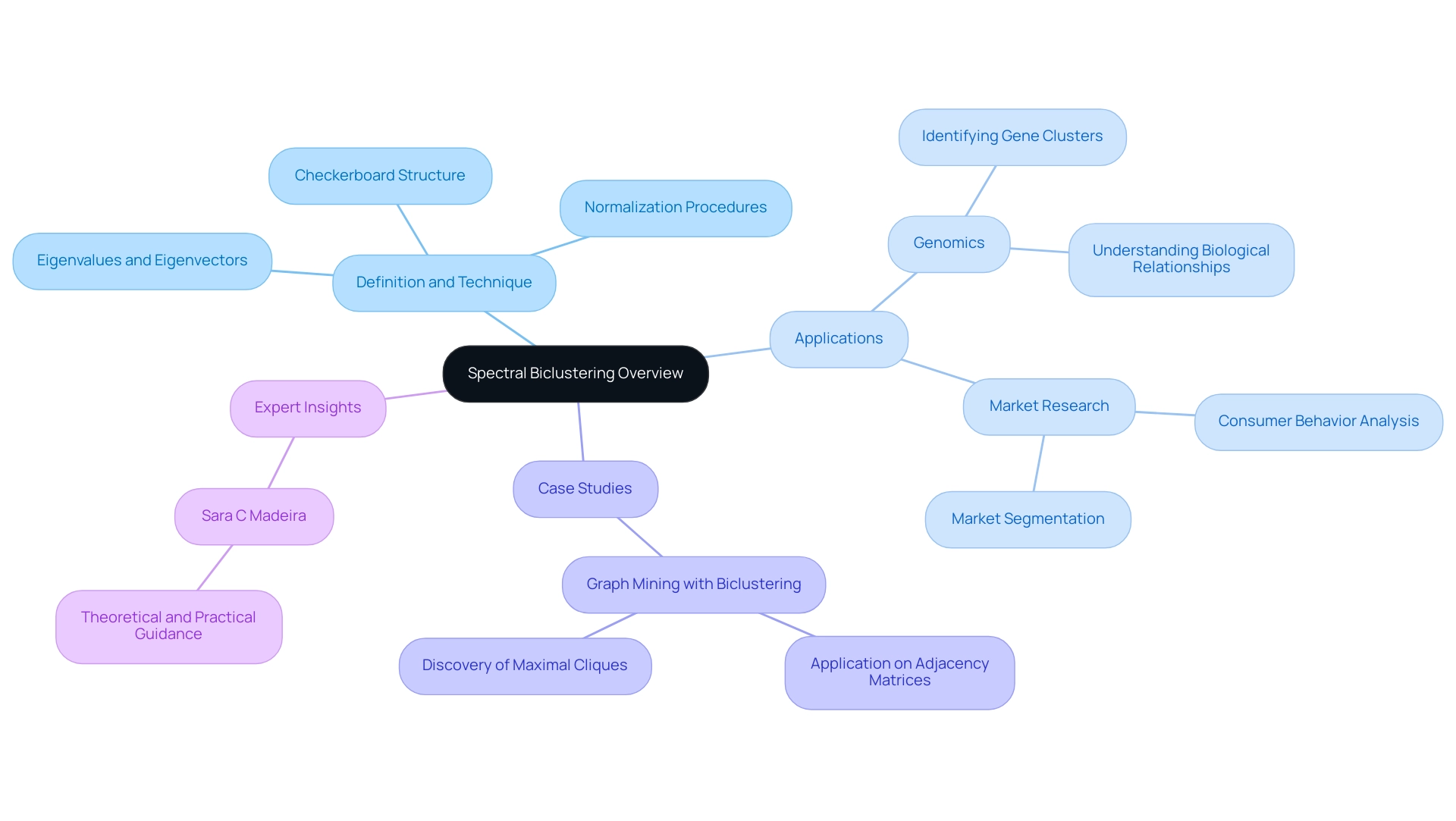
Technique 2: BiMax Biclustering – Key Features and Applications
Bi clustering stands out as a powerful technique specifically designed to identify maximal biclusters within binary matrices. This method works by recursively partitioning the information into submatrices that exclusively contain 1’s, thereby revealing groups of items that share common attributes. Its application in bioinformatics is particularly noteworthy, especially in analyzing gene expression data, where it effectively uncovers co-expressed genes across various conditions.
The efficiency of BiMax in processing binary data has made it a favored choice among researchers engaged in bi clustering within the field.
As we look to 2025, the significance of bi clustering using BiMax bicluster analysis continues to expand, with applications proliferating across diverse areas of bioinformatics. For instance, recent studies underscore its utility in gene expression analysis, aiding in the identification of significant patterns that inform research on genetic interactions and disease mechanisms. The synergy of bicluster analysis with RNA-seq data further enhances the capacity to study individual cell heterogeneity, offering deeper insights into cellular behaviors and responses.
Moreover, the computational efficiency of bi clustering through BiMax bicluster analysis is pivotal to its adoption. Despite the inherent challenges posed by NP-completeness in grouping algorithms, advancements in search strategies have bolstered its performance, establishing it as a viable option for large datasets. A notable case study involving the subsystem analysis of HIV-1 interactions utilized BiMax to identify 279 significant sets of host proteins interacting with the virus, showcasing its practical application in real-world scenarios.
This case study highlights the effectiveness of BiMax in facilitating the construction of a bi clustering distance matrix, essential for understanding complex biological interactions.
Furthermore, the dataset accession number for Buettner (E-MTAB-2805) serves as a solid reference point for readers interested in specific sources related to cluster analysis research. Jing Zhao, an assistant research scientist at Sanford Research and an assistant professor at the Department of Internal Medicine, University of South Dakota Sanford School of Medicine, emphasizes the significance of BiMax in advancing bioinformatics research, stating, “BiMax provides a robust framework for uncovering hidden patterns in complex datasets, ultimately driving innovation in the field.”
Overall, bi clustering with BiMax dual clustering not only simplifies analysis in bioinformatics but also empowers researchers to derive meaningful insights from intricate information sets, ultimately fostering innovation and growth in the field.
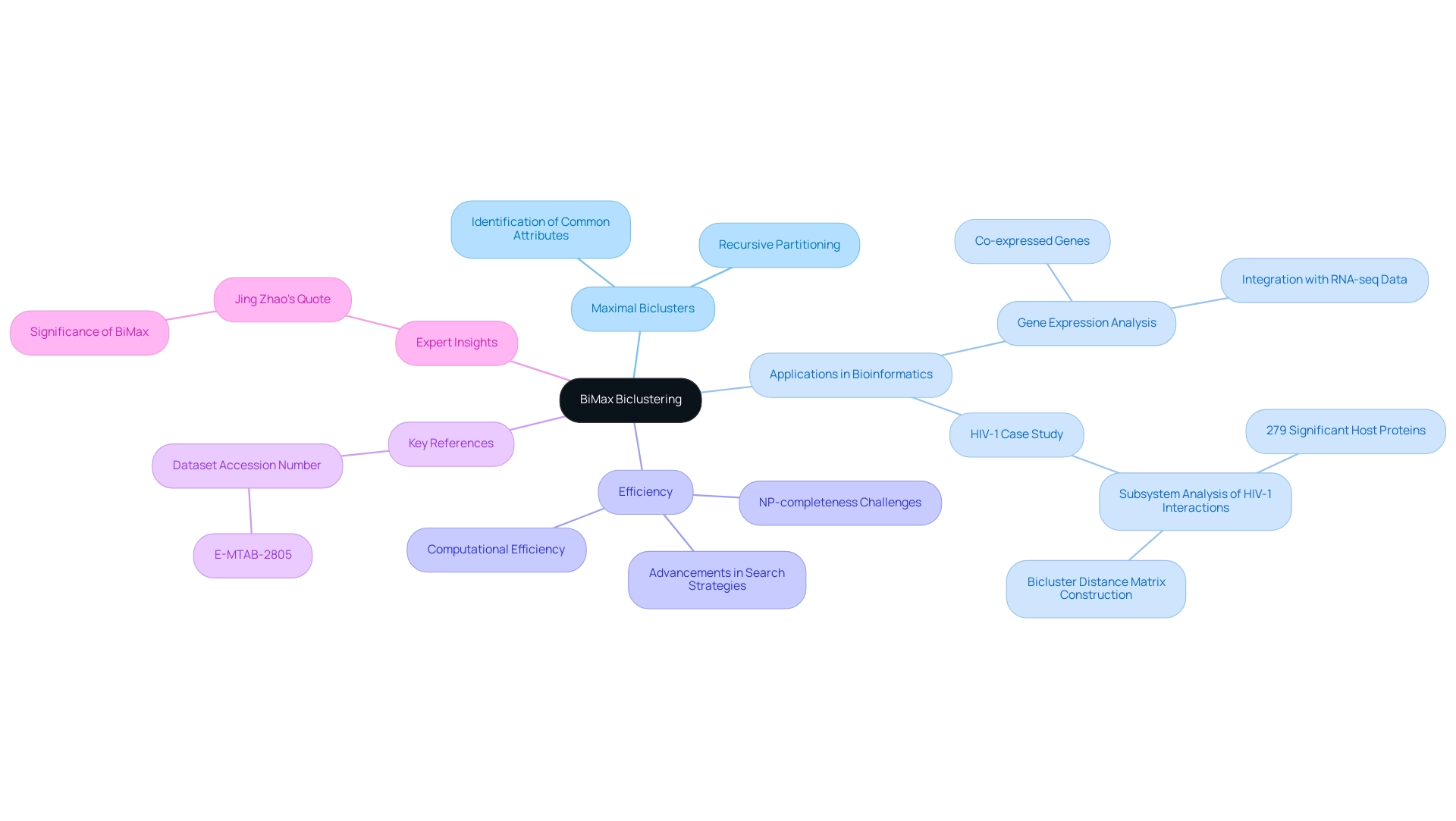
Technique 3: Iterative Signature Biclustering – Methodology and Use Cases
The Iterative Signature Algorithm (ISA) is a powerful technique designed to identify correlated blocks within information matrices. By iteratively refining clusters based on the correlation between rows and columns, ISA proves particularly effective for analyzing gene expression information. This method has been instrumental in various biological studies, revealing co-expressed genes and shedding light on intricate gene regulatory mechanisms.
For instance, in a study examining the role of DNA methylation in breast cancer, ISA facilitated the identification of distinct methylation patterns associated with different breast cancer subtypes. Such insights are crucial, as they can lead to better-targeted therapies and improved clinical outcomes for patients.
Sara C Madeira, the corresponding author, emphasizes, “We aim to provide theoretical and practical guidance about bi clustering analysis,” underscoring the significance of ISA in this field. The iterative nature of ISA not only enhances the quality of clusters but also adapts to the growing complexity of datasets, making it a robust choice for researchers. In 2025, the methodology continues to evolve, with advancements aimed at developing more efficient bi clustering algorithms to manage increasingly large datasets.
Statistics indicate that ISA has successfully extracted 1,906 genes from a dataset of 17,815 genes, demonstrating its effectiveness in distilling meaningful insights from vast amounts of information. The pattern of bi clustering simplifies its description, aiding in the identification of relationships and noise, which is invaluable for researchers navigating the complexities of modern biological studies. As the landscape of biological research grows, the uses of ISA in revealing relationships and minimizing interference in evaluations remain invaluable, establishing it as a crucial instrument for researchers aiming to navigate the complexities of contemporary biological studies.
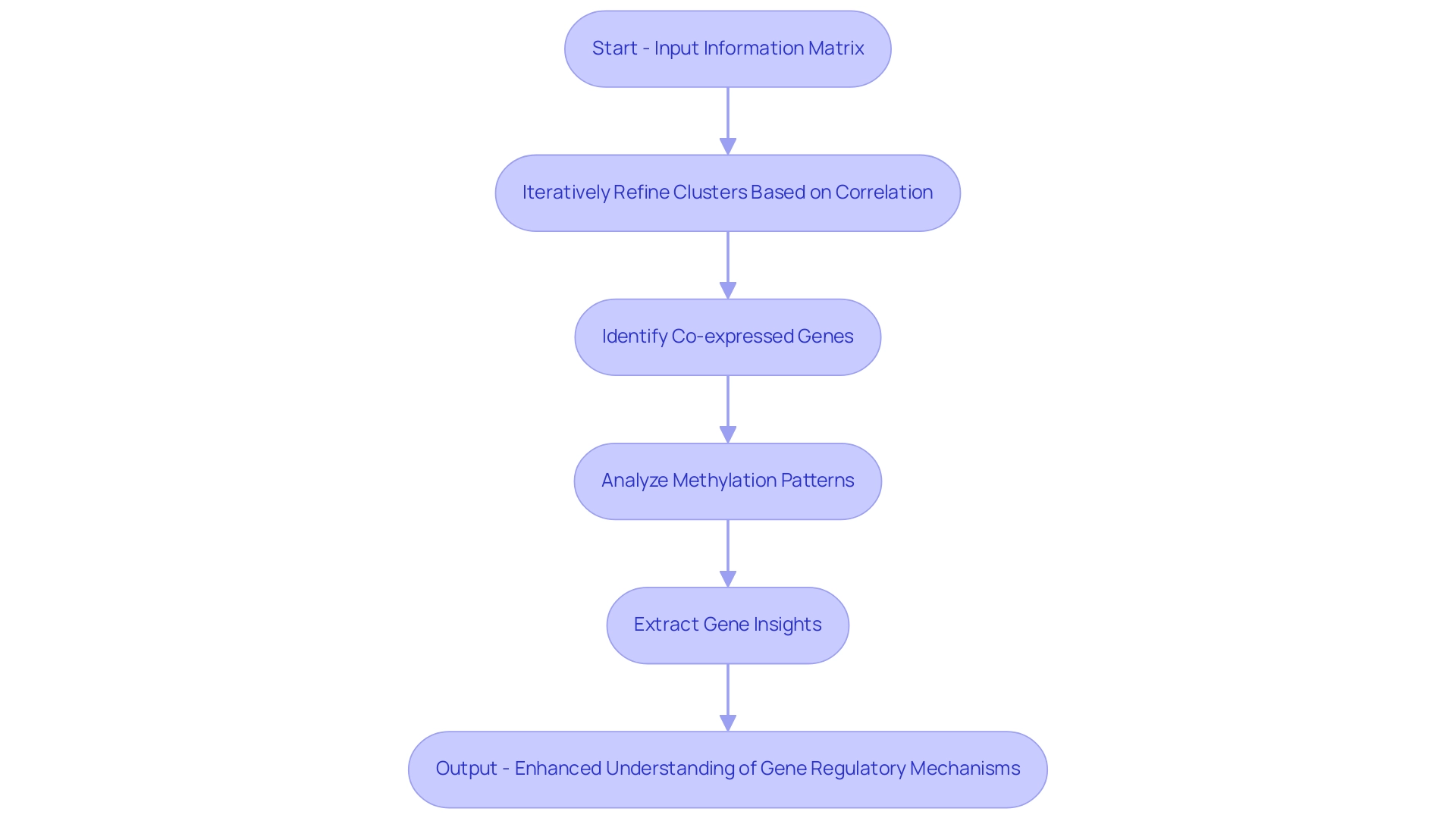
Leveraging Bi-Clustering Techniques for Enhanced Data Insights
Utilizing dual-clustering methods empowers organizations to significantly enhance their analytical capabilities, particularly in the rapidly evolving AI landscape. Each method offers unique advantages that can be tailored to specific datasets and analytical goals. For example, bi-clustering can uncover hidden patterns in gene expression data, leading to breakthroughs in biomedical research, or it can effectively segment customers in marketing analytics, facilitating targeted campaigns that resonate with distinct consumer groups.
As data volumes continue to surge—projected to reach 20.3 billion IoT connections by 2025—businesses must implement innovative strategies to navigate this complexity. Bi-clustering serves as a robust toolset for extracting meaningful insights, especially in scenarios where traditional analysis methods may prove inadequate. This aligns with the demand for customized AI solutions from Creatum GmbH, which cut through the noise and provide targeted technologies that address specific business objectives and challenges.
A compelling case study in this domain is the application of dual clustering in graph mining, illustrating how relationships between entities can be revealed within networks. By representing a matrix as a bipartite graph, grouping algorithms can identify coherent modules, enhancing the understanding of network structures. This approach has demonstrated effectiveness in both binary and weighted networks, showcasing the versatility of bi-clustering across various contexts.
The impact of dual-clustering on information insights is profound, with experts emphasizing its role in improving computational searches and streamlining the visualization of complex patterns. As Kelly C. Powell, Marketing Head & Engagement Manager at Creatum GmbH, aptly states, “We collect your requirements, we offer a solution, we succeed together!” This collaborative approach is essential as organizations prioritize information governance—an area of focus for 60% of information leaders—making combined clustering techniques crucial for managing and extracting value from the growing volume of information.
In summary, the advantages of bi-clustering for data insights are unmistakable: it enhances analytical capabilities, drives innovation, and supports informed decision-making. The structure of bi-clustering simplifies representation, aiding in the identification of relationships and improving computational searches. As businesses look to the future, mastering these techniques will be vital for remaining competitive in an increasingly data-driven environment, underscoring the importance of Business Intelligence in driving operational efficiency and growth.
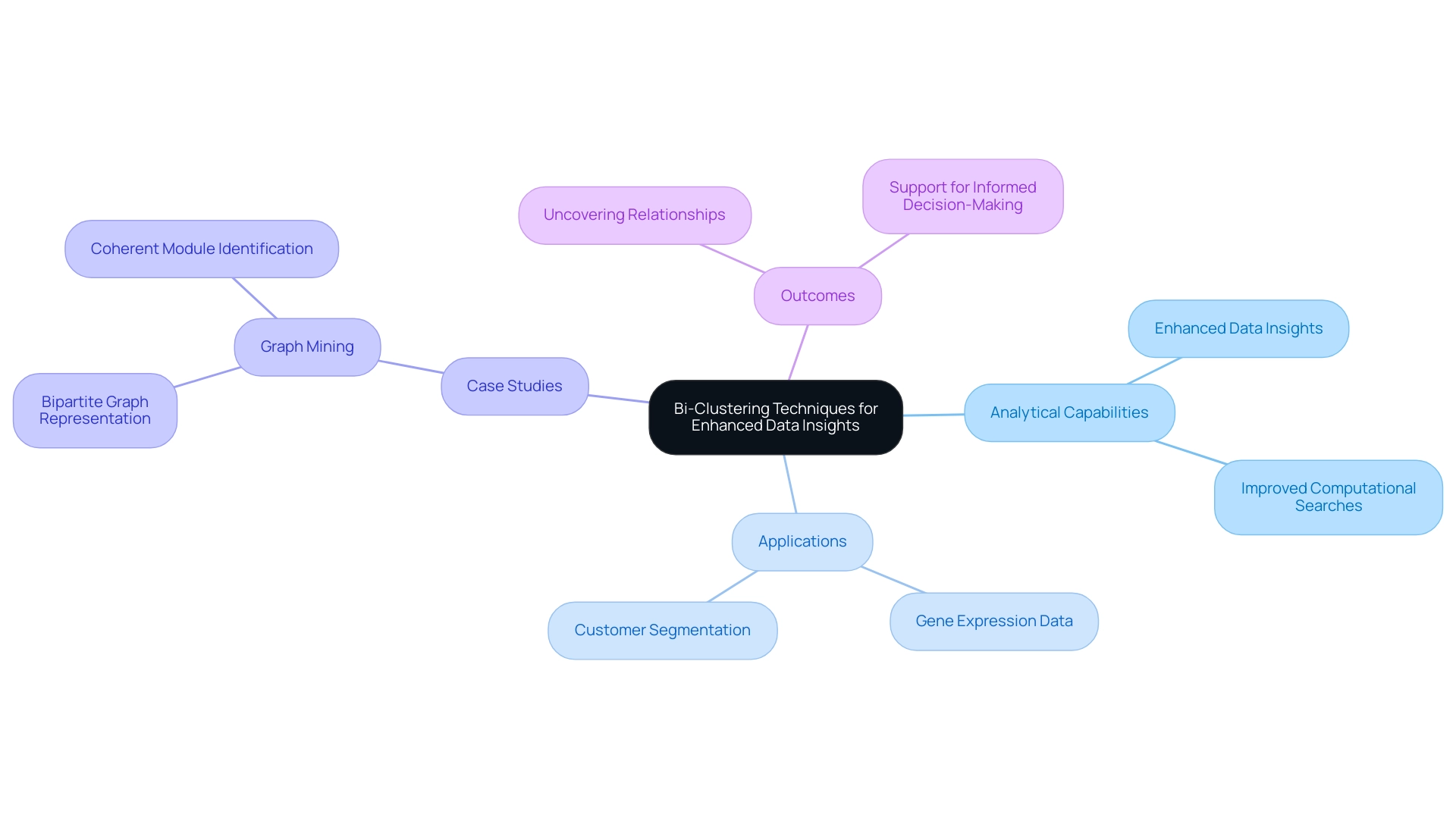
Conclusion
The exploration of bi-clustering techniques highlights their immense potential to transform data analysis practices across various fields. By simultaneously clustering both rows and columns, bi-clustering uncovers intricate patterns that traditional methods might overlook. This makes it an invaluable tool for sectors such as bioinformatics and marketing analytics. Furthermore, advancements in algorithms and machine learning integration are enhancing the effectiveness of bi-clustering, driving significant improvements in data insights and decision-making processes.
As organizations grapple with the complexities of ever-increasing data volumes, the adoption of bi-clustering will be pivotal in navigating these challenges. The ability to reveal hidden relationships within datasets fosters innovation and supports strategic initiatives that can lead to improved operational efficiencies. The case studies and statistics highlighted throughout this article underscore the growing recognition of bi-clustering as a critical component in the data analysis toolkit.
Ultimately, mastering bi-clustering techniques empowers organizations to harness the full potential of their data, paving the way for informed decision-making and competitive advantage in an increasingly data-driven landscape. Embracing these methodologies is essential for any organization aiming to thrive in the modern digital era, reinforcing the significance of bi-clustering as a key driver of innovation and growth in data analysis.
Frequently Asked Questions
What is bi clustering?
Bi clustering, also known as co-clustering or two-mode clustering, is an advanced mining technique that simultaneously organizes both rows and columns of a matrix, allowing for the examination of relationships between two distinct types of information.
In what contexts is bi clustering particularly useful?
Bi clustering is particularly advantageous in contexts such as bioinformatics, where it can analyze the relationship between genes and conditions, uncovering intricate patterns that traditional clustering methods may overlook.
How has bi clustering been applied in biomedical research?
In biomedical research, bi clustering algorithms have been utilized to analyze complex datasets, leading to breakthroughs in understanding disease mechanisms, such as identifying transcriptional modules associated with therapeutic effects in drug discovery projects.
What is the projected trend for the acceptance of dual clustering methods?
Statistics indicate a projected increase of 30% in the acceptance of dual clustering methods among researchers and institutions by 2025, highlighting the growing integration of these methods with machine learning.
What are the benefits of bi clustering in information analysis?
Bi clustering enhances the quality of insights derived from complex datasets, facilitates informed decision-making, and is crucial for organizations navigating data-rich environments, ultimately driving innovation and operational efficiency.
How does bi clustering contribute to decision-making processes?
By leveraging dual clustering, organizations can formulate more informed strategies and improve outcomes, as effective clustering techniques can significantly enhance the probability of accurately rejecting the null hypothesis.
What programming languages are commonly used for implementing bi clustering?
Popular implementations of bi clustering are predominantly developed in Python and Java, with various libraries available to facilitate its application.
How can businesses leverage bi clustering for growth?
By incorporating bi clustering into their analytical frameworks, businesses can enhance operational efficiency, foster innovation, and support data-driven decision-making, aligning with the use of Business Intelligence and Robotic Process Automation (RPA).
